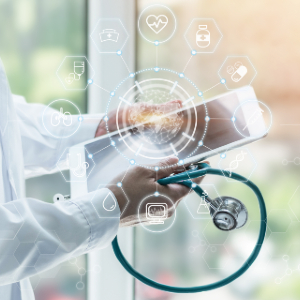
The expansion of big data applications has created opportunities across economic sectors. In healthcare, however, the potential of big data applications goes far beyond the financial. The contextual data gleaned from big data can drive healthcare solutions and accessibility to new heights.
Contextual data means improved care. With it, healthcare professionals can spot patterns in symptoms and treatment success. From there, they can apply the insights they gain to improve virtual care services. With the use of telehealth jumping up by 50% in 2020 alone, the demand for remote care is here to stay. Fortunately, contextual data is driving the future of telehealth by enabling healthcare accessibility that was never possible before.
What is Contextual Data?
Contextual data represents the background information surrounding a data point. This can be virtually anything — from clicks on a website to the appearance of a symptom. Contextual data then informs on the data by offering connections. For example, website traffic might be higher in the afternoon, or the presence of fever with other symptoms might lead to a different diagnosis.
Context is key in healthcare as much as in anything else. Big data can easily provide this context. Massive data sets can garner greater visibility into patient needs by supplying context with gathered patient information. Care professionals can use this information to paint bigger pictures of trends. At the same time, they can better personalize a treatment plan around a specific patient based on the way individual data points correlate.
For example, if patients with diabetes have reacted poorly to one medication compared to another, doctors can prescribe the proper treatment. This would be impossible, however, without context. Contextual data gives care professionals the means to understand how patient needs and available solutions interact. As a result, they can improve care outcomes.
In tele-healthcare, data is even more vital to proper treatment. Virtual doctor visits requires contextual data. Since the doctor has less physical context to work with when distant from the patient, they need contextual data to find the proper solutions.
Fortunately, telehealth also helps generate contextual data. With the opportunities enabled by virtual care access and health monitoring, a more complete picture of healthcare solutions is possible.
How Contextual Data Creates Opportunity
There is no shortage of ways data is changing healthcare. From better patient outcomes to improved financial planning, big data offers unique insights into new patterns and correlations. These opportunities are generated by the nature of telehealth and how it taps into the useful information inherent in the home environment. With remote visits with your physician and wearable health monitoring devices, contextual data is taking telehealth into the future.
One study revealed that a combination of home-environment factors determines up to 80% of health outcomes. These factors include:
- Fall risks
- Food insecurities
- Allergens
- and even medication bottles
Telehealth allows care professionals to more accurately assess these factors. As a result, telemedicine companies like Heal are taking advantage of the service to improve the lives of their patients. By reaching patients virtually in their homes, care professionals can achieve a more complete picture of their overall health.
Additionally, the use of wearable healthcare monitoring devices gives greater context for virtual care solutions. With more than 80% of all consumers indicating that they would be willing to wear fitness and health devices like the popular Fitbit, physicians can gather more information. From ECG monitors to heart rate biosensors, wearables offer the potential to collect invaluable patient data.
Then, care providers can apply big data analytics tools to better understand exactly what is happening with the patient and what they need. These analytics systems, powered by artificial intelligence (AI), are already giving rise to all kinds of incredible telehealth diagnostic capabilities. For example, AI has outperformed the majority of dermatologists in diagnosing melanoma accurately. This AI, applied to telehealth platforms, can help prevent death and disease while providing greater patient accessibility.
With telehealth, all a patient needs are an internet connection and a video conferencing device. The majority of adults increasingly have both. This allows patients who would otherwise be dissuaded from visiting the doctor because of travel costs or health concerns to easily acquire the care they need.
For these reasons, the power of contextual data is driving the future of telehealth.
The Future of Telehealth
Every day, tech advancements give rise to greater care solutions. However, these advancements are often only as good as the data they have to work with. The future of healthcare information systems relies heavily on the ability of care professionals to safely store and analyze this data while maintaining patient privacy. This includes securing telehealth systems.
The future of telehealth, powered by contextual data, will be emboldened by greater remote care solutions. In turn, AI threat-monitoring across telemedicine databases can provide better protection of patient data. As a result, applying and supporting telehealth services means safer, better, and more accessible healthcare. From home environment analysis to diagnostic tools, telehealth is driven by contextual data. In the future, who knows what health solutions will be possible as a result of these tools?
